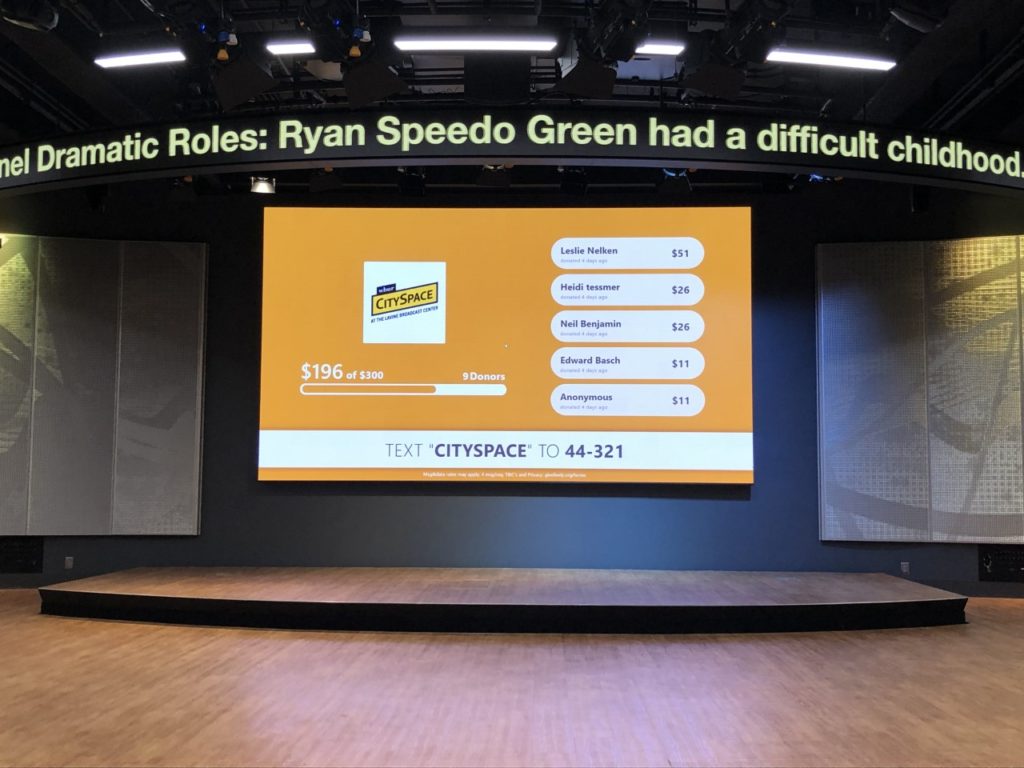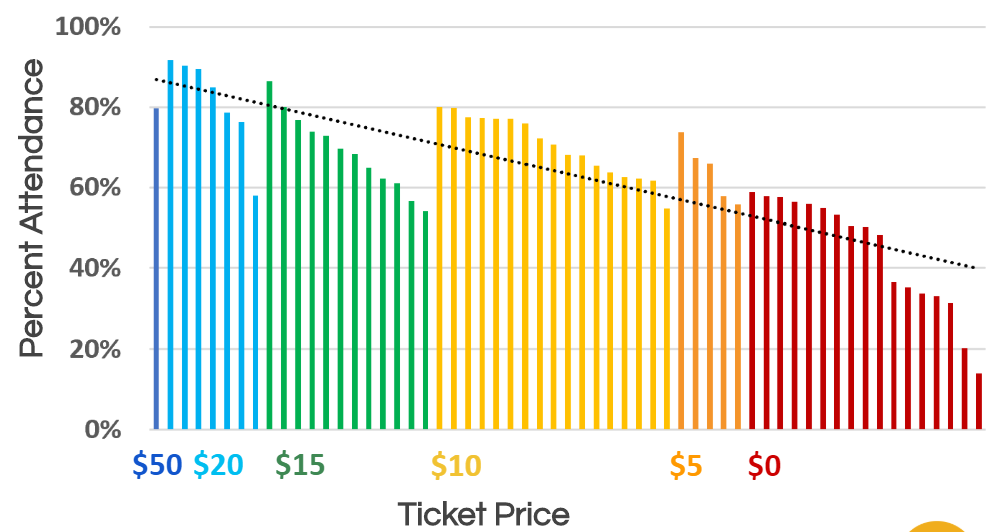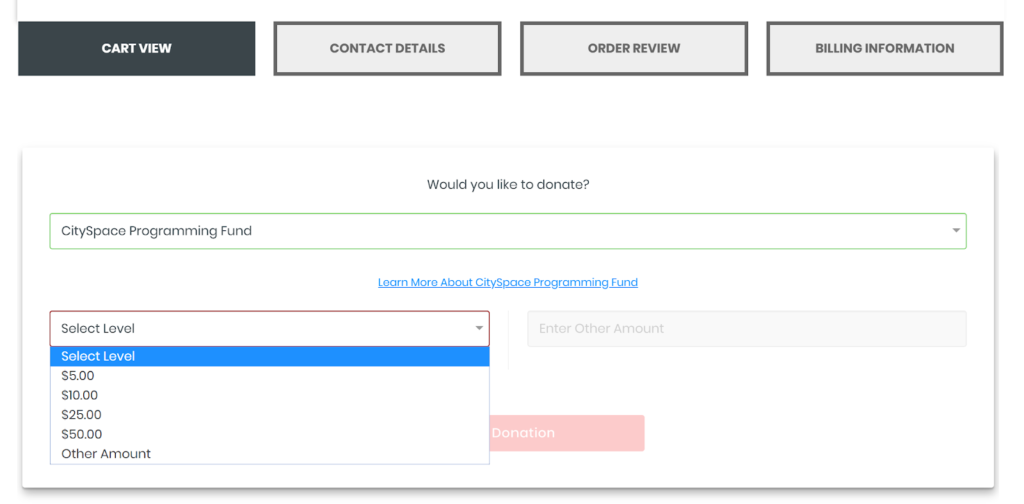This is the third post of a three part series about BizLab’s work with WBUR CitySpace. This post discusses two donation experiments and modeling of ticket sales revenue. If your station hosts events and has been unsure about how to ask for donations and approach ticket pricing, this post is for you!
[I’m Sarah Barden, a BizLab Summer Fellow investigating revenue streams for WBUR CitySpace. I just graduated from a dual degree program between Wellesley College and Olin College studying mathematics, engineering, and user experience design, and I’ve started a Master’s in Engineering Management at Dartmouth this fall.]
Two main ways to generate revenue from your audience at events are through tickets sales and donations. Making revenue through tickets sales has been CitySpace’s main source of audience revenue so far, with about $58,000 in net ticket revenue for events since opening in February, through the end of July.
Asking for Donation at Events
Prior to this summer, CitySpace had not asked event attendees for donations. Based on our data analysis, that over 70% of our attendees are not WBUR donors, yet the majority of event attendees are WBUR listeners and familiar with WBUR’s events and content.
Because of this, we hypothesized this audience was primed to give to WBUR’s CitySpace. So we decided to test asking for donations both at the event and at the moment of ticket purchase. For our testing, we used two different platforms: GiveLively, a donation platform, and OvationTix, our existing ticketing system.
We first used GiveLively to test live donations asks during events at CitySpace. The GiveLively fundraising platform is free for nonprofits that includes text-to-initiate donations and a live display showing real-time donations. During events, we could project a screen with instructions on how to donate: 
When attendees text “cityspace” to the number 44-321, they receive a donation link where they can donate using Google/Apple Pay or credit/debit card. The mobile-friendly webpage is shown below:
We made asks at three different events, receiving $216 in donations from 11 donors. There were 306 attendees total over these three events, so only 3.6% of attendees donated, and donated an average of $19.64 per donation. We had widely varied results across events: most of the 11 donations came from just one event, which we suspect has to do with the emotional content of the event, inspiring people to donate.
Asking for Donations at Ticket Purchase
After the event donation experiments, we turned on the ability for people to donate to WBUR CitySpace while purchasing or reserving tickets through our ticketing system, OvationTix.
In the first two weeks this capability was on, we received $167 from 27 donors. There were 585 ticket transactions total, so 4.6% of ticket buyers added a donation — a higher percentage than asking for donations with GiveLively at events.
There was an average of $6.19 per donation, which was significantly less than the average donation through GiveLively. This is likely due to the recommended donation amounts displayed. As seen in the screenshots below, the OvationTix preset amounts were 5, 10, 25, and 50, whereas in the GiveLively test, the presets were 10, 25, 50, and 100.
Our experiments found that the effort to raise donations at events was high (because of our team needing to break the event flow and coach people on texting to donate) and the yield was lower than the zero effort approach of asking ticket purchasers for donations. Our team will continue to run experiments, including one where OvationTix is set to the same preset amounts as GiveLively, to compare more easily. But our overall conclusion is that donations are best asked at the time of ticket purchase.
Ticket Pricing
Ticket sales were an existing revenue stream for CitySpace, and we wanted to analyze ways in which this revenue could be increased. Since opening, most events at CitySpace were priced between $0 to $20. We hosted 17 free events, 5 $5 events, 17 $10 events, 12 $15 events, 7 $20 events, and 1 $50 event.
In the survey discussed in my prior post, we found that price was not a driving factor in attending (which indicates price flexibility) and we received comments about pricing such as “Very reasonably priced which makes it affordable for a broader audience than many other events.” ($20 show) and “Thank you for making this affordable for the whole family.” ($20 show).
This led us to believe that we could raise prices for certain events, but how much and when? Our CitySpace team wants to keep some low prices to have an economically, geographically, and racially diverse audience. Raising the price of all events to $50+ would make events economically out of reach for a desired population. But tickets can not always be free or below cost, because CitySpace needs to remain financially sustainable.
More evidence for raising ticket prices is the relationship between ticket prices and attendance. In analyzing audience data, we found that that a lower ticket price is correlated with lower attendance. In the chart below, each of the vertical bars is one CitySpace event and the height of the bar is percent of ticket purchasers who attended. If 200 people bought tickets and 100 people came, the bar would be at 50% attendance. The data shows that as the price for events decreases, the percentage of attendees decreases. This relationship makes sense because the more you have financially invested in an event, the more likely it is that you will want to cash in on that investment by attending the event.
Because CitySpace wants to have some free and low cost tickets to not exclude any groups from attending, a mechanism for addressing the willingness of some to pay higher prices is variable pricing, which is offering different ticket prices for different levels of perks at an event.
Variable pricing is also a way to increase the number of attendees at an event. If tickets are $20, that might attract 100 people to the event. If there is also a discount ticket price for $10, it can attracts students, senior, or low-income individuals that otherwise would not have come. If there is also a high ticket price for $40 with better seats, for example, this attracts people who have more disposable income and perceive an added value for attending.
In analytical terms, a flat price of $20 might only make $2,000 in revenue, but with three different ticket prices, revenue increases to $3,000. The 100 people who bought regular tickets will still attend the event, but different ticket prices attract new buyers, as outlined in the table below:
| Price | Tickets Bought | Price | Tickets Bought | ||
| Discounted Price | $10 | 20 | |||
| Regular Price | $20 | 100 | $20 | 100 | |
| Higher Price | $40 | 20 | |||
| Total Revenue | $2,000 | $3,000 | |||
To predict future ticket sales revenue based on variable pricing, you can use spreadsheet calculations to plan out how many events of each ticket price you plan to hold. For example, say you plan to aim for 60 events in a year and want half to be free or low cost. Predicting the tickets sold per event and how many of each event will show the total revenue for those events. You can add to this basic model premium and discount pricing, to fine tune the model to determine where variable pricing will most increase revenue.
| Event type | Price of event | Number of events | Tickets sold per event | Revenue |
| Free event | $0 | 10 | 100 | $ – |
| Low price event | $10 | 20 | 100 | $ 20,000 |
| Standard event | $25 | 20 | 100 | $ 50,000 |
| High demand event | $50 | 10 | 100 | $ 50,000 |
| Total | 60 | 400 | $ 120,000 |
The CitySpace team is currently testing variable pricing for events this fall, where higher ticket prices get front row seating and sometimes an extra gift, and they will be evaluating the revenue generated from these events.
Summary
- For donations at events, we recommend choosing the ask strategy that works for you. In CitySpace’s case, using our ticketing platform to allow ticket purchasers to simply add on a donation was the best route forward, and doing live donation asks will only be done at a few events, since it is not feasible for the team to do live asks at all events. For events where your audience is seated for a long, unique event with breaks, like a conference, gala, or dinner, live asks may work very well.
- Variable pricing is a wise move to increase revenue while keeping events affordable for certain populations. In particular, variable pricing can attract new attendees that would not have otherwise come. It is worth it to try this method at a few events to test out logistics, revenue amounts, and attendance.


